Coronavirus Data from US Cities: Residents’ key concerns in numbers

Eyal Feder Levy
CEO & Co-Founder
As the coronavirus starts to spread across the US, so too has online discourse about the new pandemic, including questions, concerns and misinformation.
Subsequently, local government agencies across the country find themselves on the frontlines of tackling this crisis – shaping social distancing policies, supporting local businesses, and, more than all, providing relevant information to their communities by handling public inquiries, taking service requests, and providing responsible, accurate information to their residents.
One of the key questions these organizations face as they handle this crisis, make policy decisions, and shape their messaging to their communities – is what are their residents’ main concerns. What are the things they should take into account when taking action and sharing messages?
To support this acute need, we took a deep dive into millions of online public conversations from over 100 US cities to highlight key discourse trends on the coronavirus pandemic.
Residents are talking about COVID-19 - here’s what they’re saying. In numbers.
At Zencity, we help local governments understand their community's needs and priorities by analyzing millions of aggregated, anonymized public online conversations in their communities. We can recognize the topics, clusters, and sentiments being discussed and recognize key trends and needs. (Learn more about our AI-powered platform here).
Since March 1st, we analyzed more than 1.5 million online interactions about the coronavirus from over 100 cities and counties across the US. Here is what we found.
((In the context of our reporting, the term ‘interactions’ encompasses all engagements made on social media (posts, tweets, likes, comments, shares, retweets, etc.). The number of interactions, therefore, reflects the volume of discourse and as such – the level of interest.))
Takeaway #1 - Coronavirus dominated the conversations on the resident side.
While it might feel like the conversation on COVID-19 is only happening in the media, our analysis found that city residents are very actively engaged in this conversation. While on average, public health-related conversations only make up for less than 5% of resident comments, since March 1st, we see more than 21% of the comments being about Public Health.
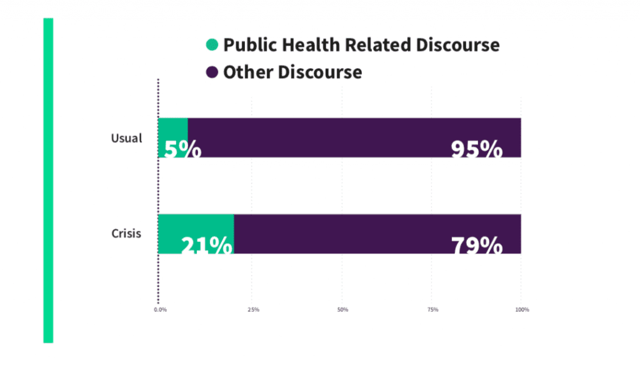
We can also see that the main topics being discussed across communities changed significantly as the outbreak started. While normally, public safety-related topics control community concerns (with 18% of the discussion), since the outbreak, we can see that public health, schools, and festivals/events are the main topics, all in relation to coronavirus.
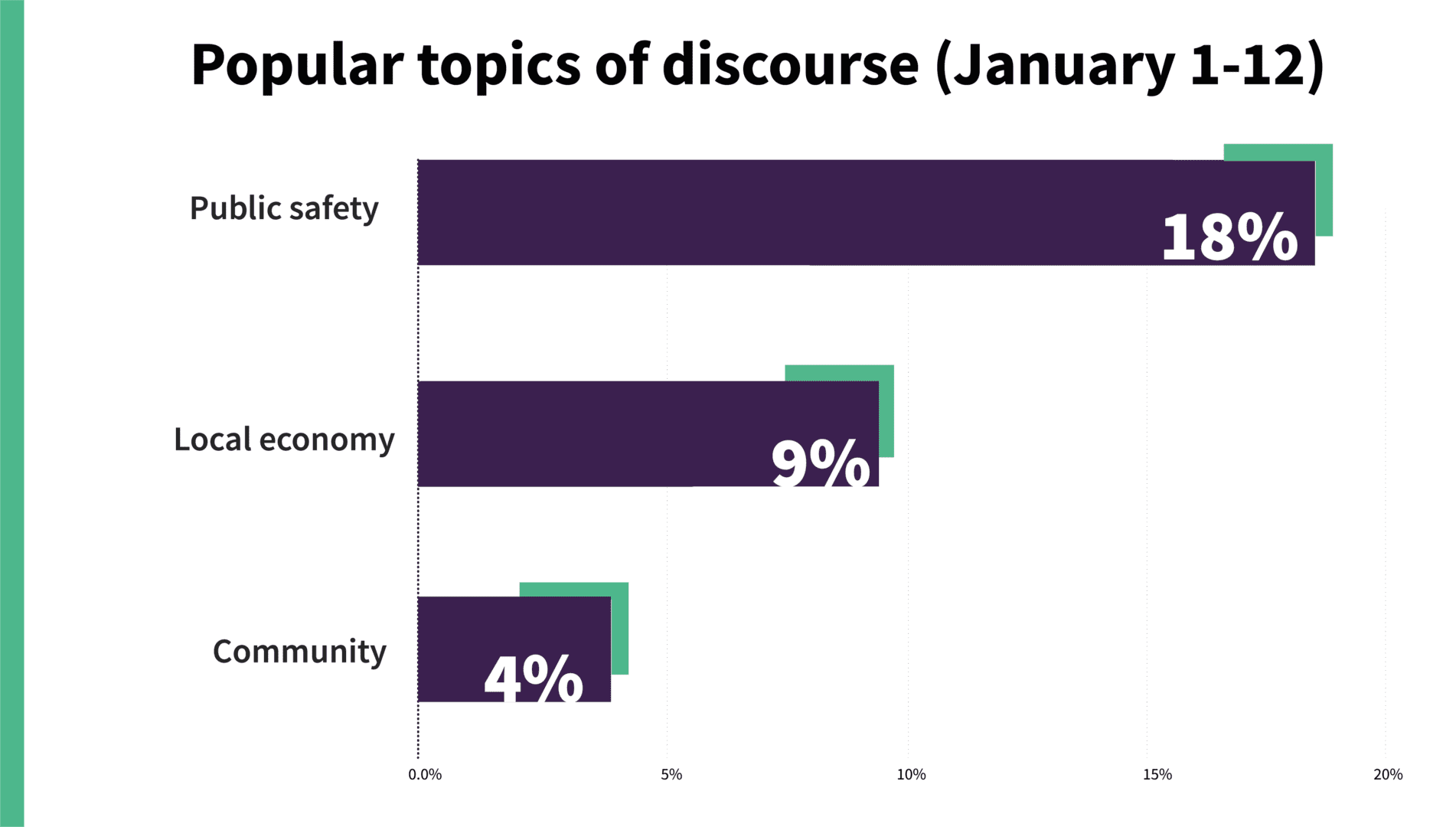
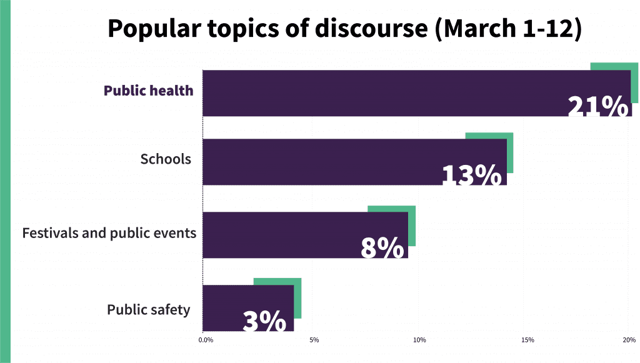
Moreover, an analysis of popular terms used shows us that keywords that have to do with coronavirus were much more commonly used than any other terms (the larger the word is the more repetitive it was).
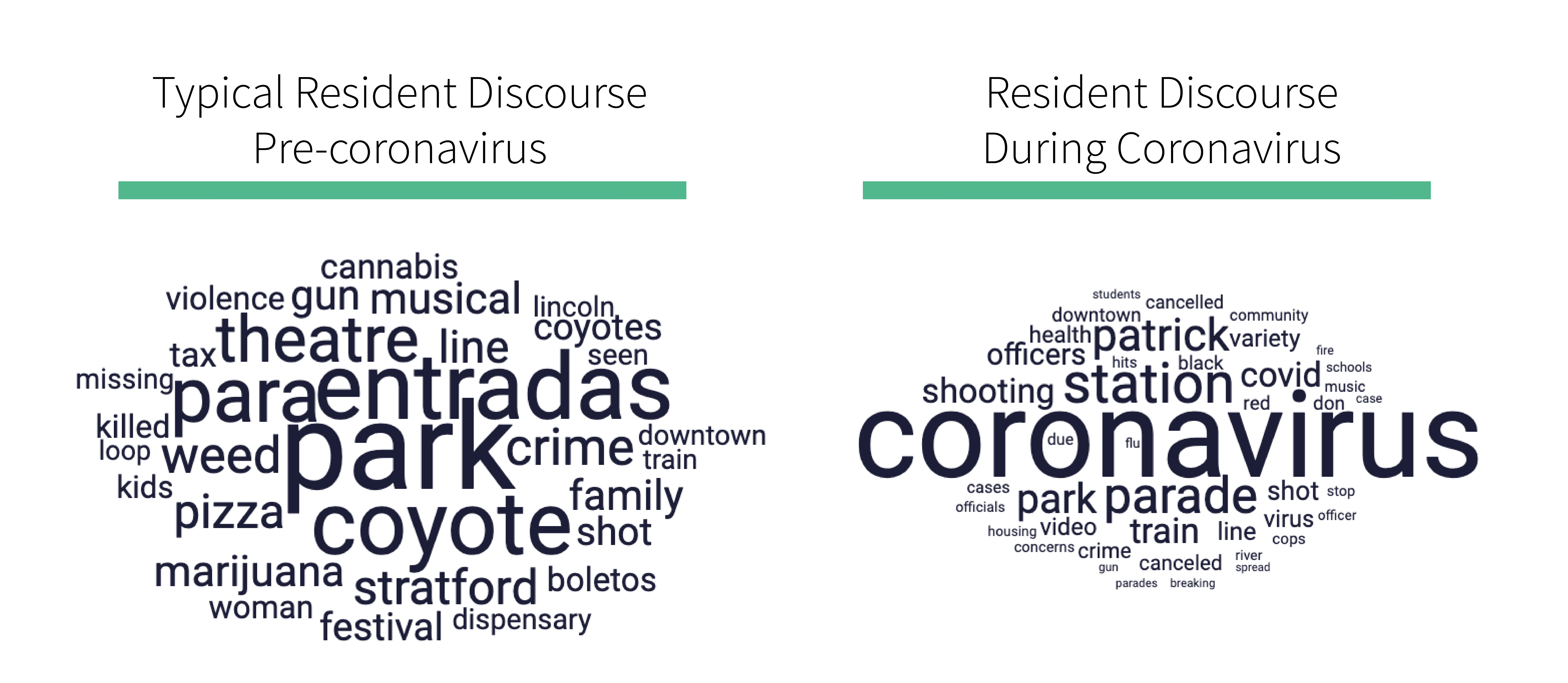
Takeaway #2 - What are residents' key concerns surrounding coronavirus?
But what were all of these comments about? What are the main things concerning communities across the US? What questions do people have? Using topic modeling and clustering, we were able to identify what people are specifically talking about and, by extension, most interested in or concerned with. This information can help local government officials shape both policy and messaging, focusing on the issues that people care about the most. From our analysis, we were able to conclude that residents primarily express concern about the following issues:
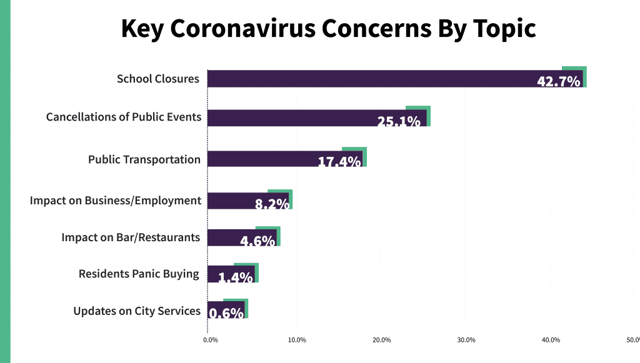
Below we’ve provided an analysis of the above graph and essential takeaways on what residents are saying.
- School closures – The most prominent cause of uncertainty and concern within communities across cities was the topic of schools and whether they are expected to close. Other than concern over whether schools will be open or closed, we also saw ongoing criticism of decisions to cancel classes in schools and universities, and residents supporting taking preparedness measures in schools (cleanliness and sanitizing). This makes sense, as we see that many school districts have begun to mandate closures and that universities are also canceling classes and moving online amid coronavirus fears. This online community discourse is in line with UNESCO’s most recent report on March 11th, noting that “Twenty-two countries have shut schools nationwide, impacting almost 372.3 million children and youth.”
- Public events – Residents focused significantly on the status of public events in the city, such as major political rallies or St. Patrick’s Day parade, and whether these events should be held as normal or canceled. Other than calls to cancel public events, we also saw criticism from residents about failure to make a decision and to notify about cancellation, and a concern about the influx of visitors coming to the city. Major publications such as Business Insider and the New York Times have begun to assemble lists of major, national events that have been canceled due to coronavirus. Accordingly, we are seeing that subsequent impact on the local level in terms of increased public support of official cancellations.
- Transit – Public transportation was discussed in the context of cleanliness and precautions being taken in airports and in buses, and cancellation of transit and flights. Studies in recent years show that there is a link between public transit use and the spread of disease and many residents are privy to this correlation. Accordingly, many local governments have implemented deep cleaning initiatives and released messaging to quell public anxiety yet also avoid usage of public transportation when possible.
- Impact on Business/Employment – a little over 8% of the conversations we analyzed touched on the topic of business activity, including residents sharing general concerns about the economy slowing down due to the crisis and jobs being affected. Moreover, we also saw concern over industries reliant on imported goods and how they will be affected, as well as debates over closing shopping malls and businesses after suspected cases of coronavirus.
- Impact on Restaurants, Bars, and Tourism – In conjunction with discussions surrounding economic and employment consequences, residents were also preoccupied with the impact on local businesses (specifically leisure and dining establishments) and the decrease in tourism. One of the key areas of discussion was Asian-owned businesses being abandoned by patrons, because of misinformation spreading in different communities. Other than that, we also saw people sharing their concerns about going out and local restaurants and entertainment centers that have been adversely affected sharing their perspectives. Small businesses are undoubtedly feeling the brunt of the coronavirus. Correspondingly, local governments and major companies (like Amazon) have set up noteworthy relief funds and services.
- Panic Buying – In times of crisis, panic buying and stockpiling are inherent human reactions, and this can also be seen during the coronavirus outbreak. Stores across the USA are being stripped bare and bombarded by demands from residents. Residents have also taken to social media to report shortages of basic necessities such as toilet paper and sanitizer.
- City Services and Operation – Lastly, a very small share of the discourse that we analyzed highlighted community concerns over the ongoing operations of regular city services, such as waste collection and public works. We attest this to the trust people have in their local government, and that they rely on these services to stay operational. Therefore, if any changes are planned in these services, we believe messaging will play a critical role.
Takeaway #3 - State Discourse Trends on Coronavirus Over Time
As coronavirus impacts specific regions in the USA in different ways, we wanted to examine how the online community discourse varied across multiple states and how it evolved over time. By analyzing the discourse starting on February 1st, 2020 in three of the U.S. states with confirmed cases of coronavirus (California, Florida, and Texas), it is possible to detect a clear trend:
The volume of discourse about coronavirus was relatively low throughout February but picked up intensely at the end of February-early March, as residents of these states first tested positive for coronavirus and events began to be canceled.
While the crisis is the same crisis along with the issues that residents are concerned with, we do see differences in priorities and conversation drivers across regions, which might require different actions from local governments. While in California school closures were a major driver of discourse, conversation in Florida was centered on the possible impact on the local economy. In Texas, the discourse was driven by proactive measures and preparedness efforts across the state. In addition, the mishandling of patients by the official authorities was another central driver of conversation. Later on, a large share of the discourse focused on events being canceled.
Below, we’ve zoomed in on key online conversations in California, Florida, and Texas to examine how conversations vary state by state.
Coronavirus in California
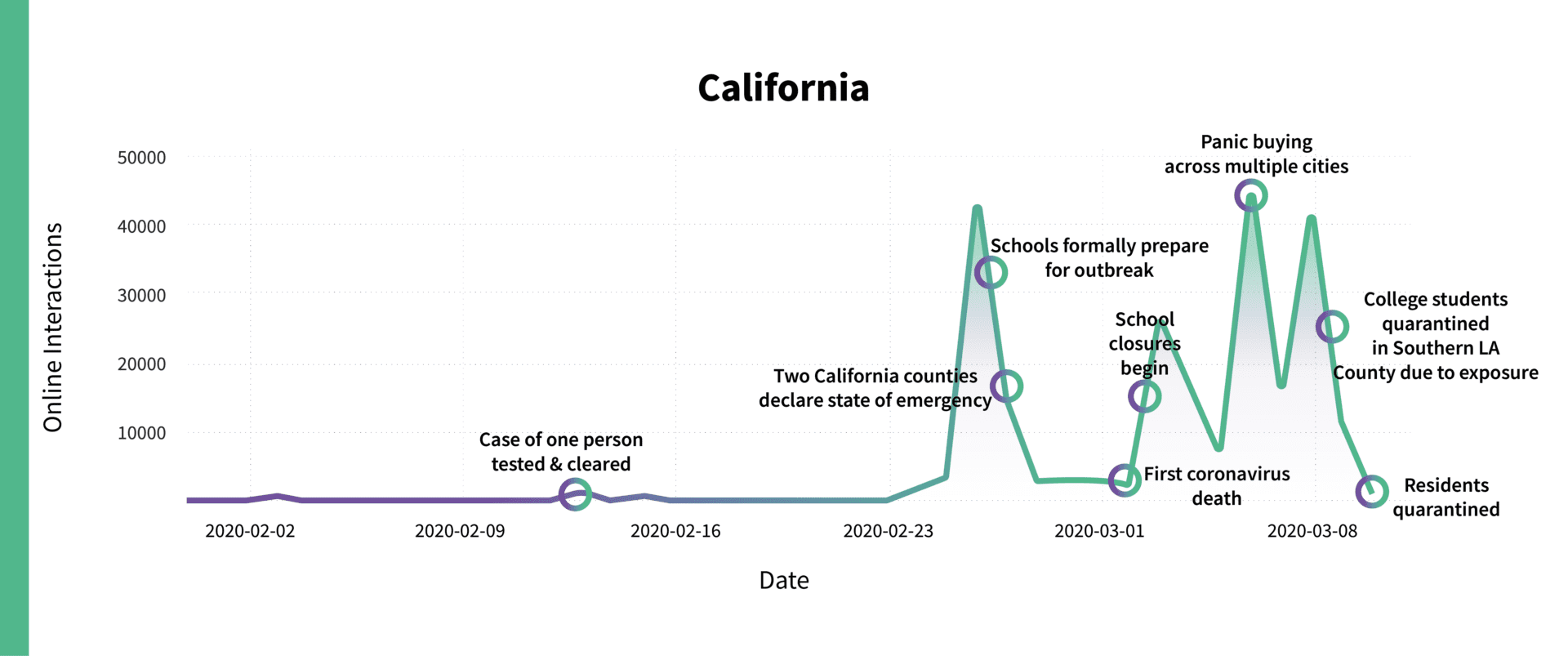
- In California, discourse in February was centered around unconfirmed cases, the testing of people for coronavirus, and updates about the monitoring of the situation.
- The first major peak in discourse volume about the coronavirus, on February 27th, came about following an announcement that schools are preparing for an outbreak. School closures were also the cause for a second sharp peak in discourse on March 7th.
- The state’s first death from coronavirus caused another peak in discourse. Additionally, reports about residents quarantined in various cities in California drove further online discourse.
- Overall, aside from discourse surrounding confirmed and suspected cases in the state, discourse mostly revolved around school closures and city preparedness.
Coronavirus in Florida
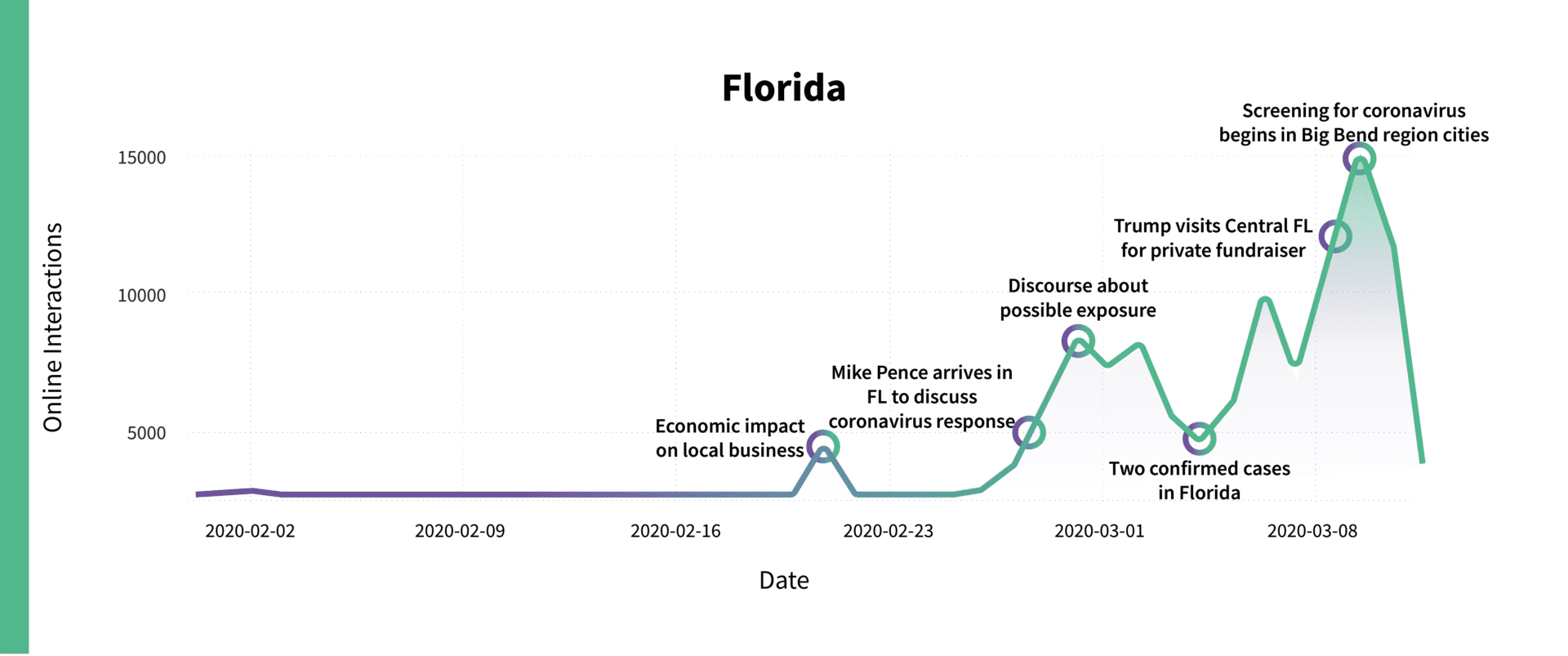
- In the middle of February, discourse around coronavirus saw a small peak as residents began to discuss the potential negative economic impact, particularly concerning local businesses
- Towards the end of February and the beginning of March, there was another spike in online discourse in coordination with Mike Pence’s arrival to the state to discuss a tactical coronavirus response
- Subsequently, online discourse showed a significant peak after two cases of the coronavirus were confirmed in Florida and following Trump’s visit for a private fundraiser
Coronavirus in Texas
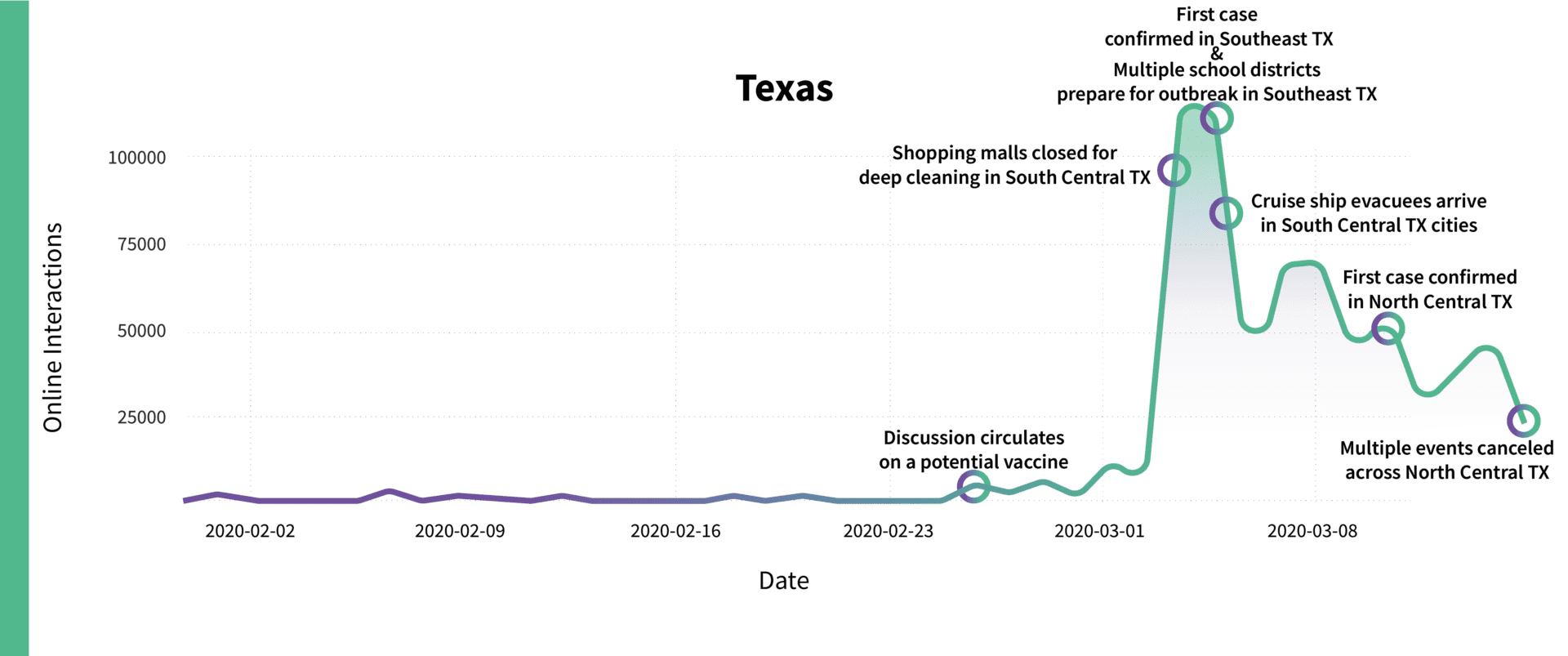
- From February 24-26, discourse about a potential vaccine for coronavirus created a small peak in discourse.
- Early March saw a peak in the discourse around proactive measures being taken in communities across the state (especially in Southeast TX), such as declarations of public health emergencies and large-scale cleaning operations in malls and public areas.
- A major peak in the discourse on coronavirus occurred at the beginning of March when the first case was confirmed in Southeast TX
- Starting on March 5th, online discourse began to focus on confirmed cases in the state, containment fears, and subsequent event cancellations.
In all three states, discourse peaked around reports of suspected or confirmed cases of coronavirus in the state.
Considering this, despite the fact that local governments are all facing a similar challenge, they will be required to respond in a way that is tailored to the specific concerns of their residents – providing certainty about essential and non-essential city services, assuaging economic anxiety, instructing residents about the status of services not necessarily provided by the city, and, as the crisis progresses, additional concerns will likely surface.
To help communications teams produce effective COVID-19 messaging for social media, the Zencity team created a list of best practices, based on the analysis of over 92K tweets and posts from 100+ US cities and counties.
How can this be useful?
The men and women of local governments, Public Safety, and Public Health organizations are at the frontlines of tackling this crisis. One of their key responsibilities at this time is to share effective and reliable information with their communities and to take immediate action around the issues that concern their residents. This report, aggregated from the real discourse of multiple communities, provides an understanding of what are some of the key issues every city/county needs to be tackling to directly address their community's needs.
We salute these professionals for carrying out their vital tasks at this crucial time. Learn more on how Zencity can support local governments in managing their response to COVID-19 in our Coronavirus Action Plan.
%20copy-1.png?width=544&height=120&name=Logo_black%20(1)%20copy-1.png)



